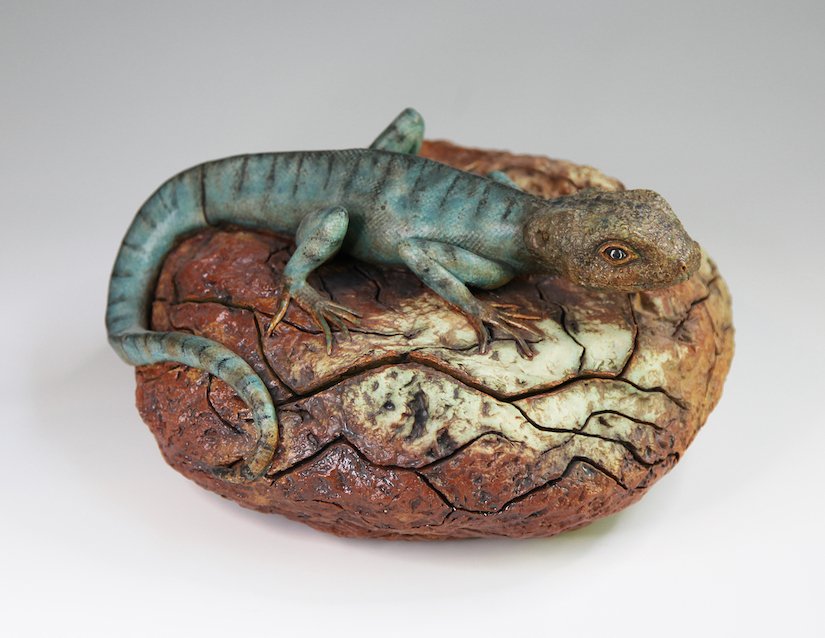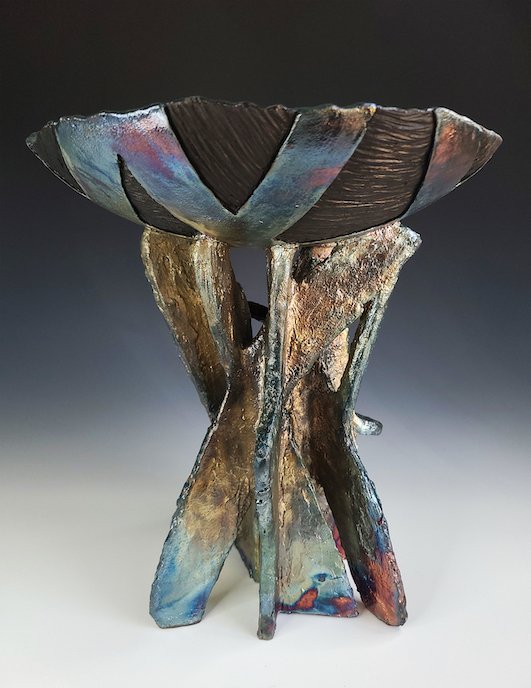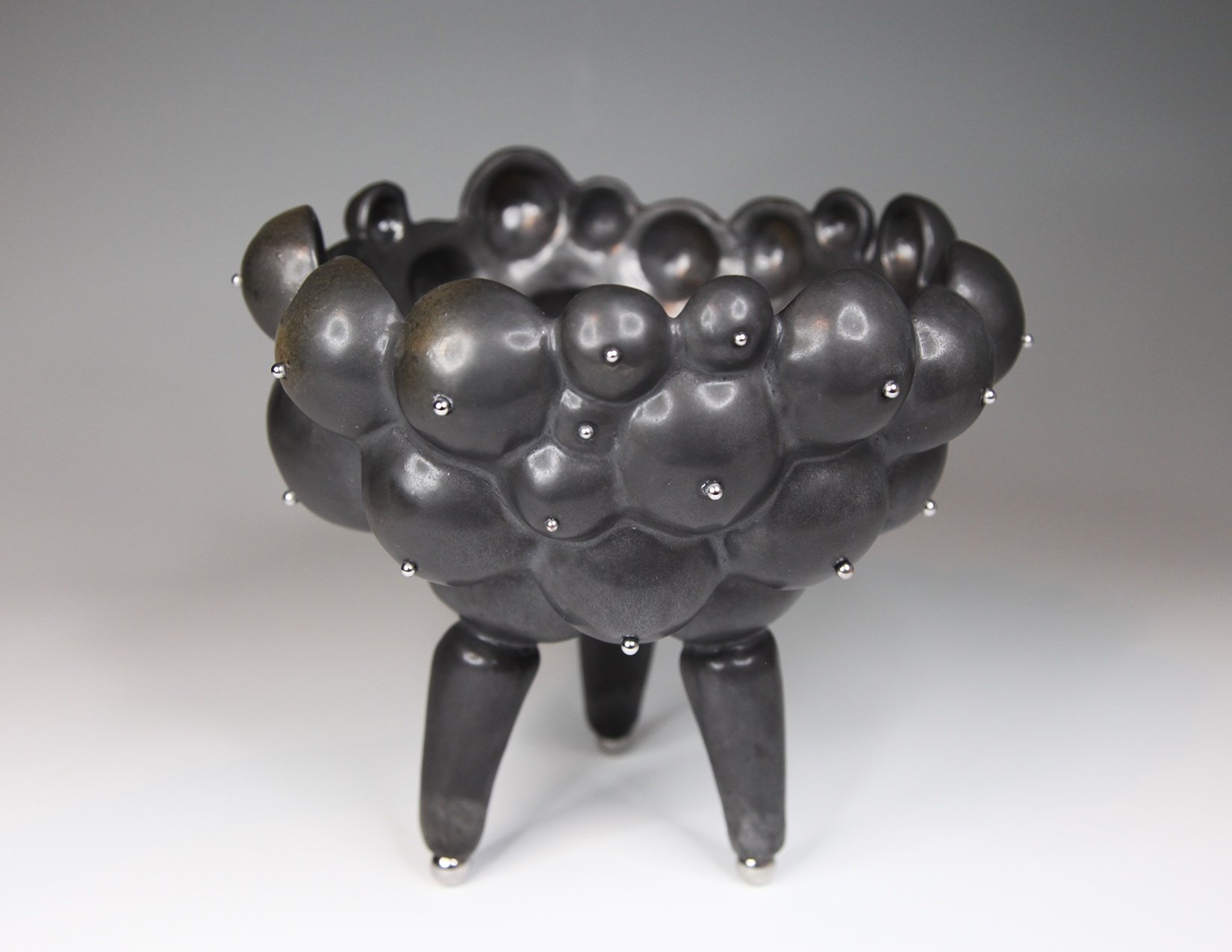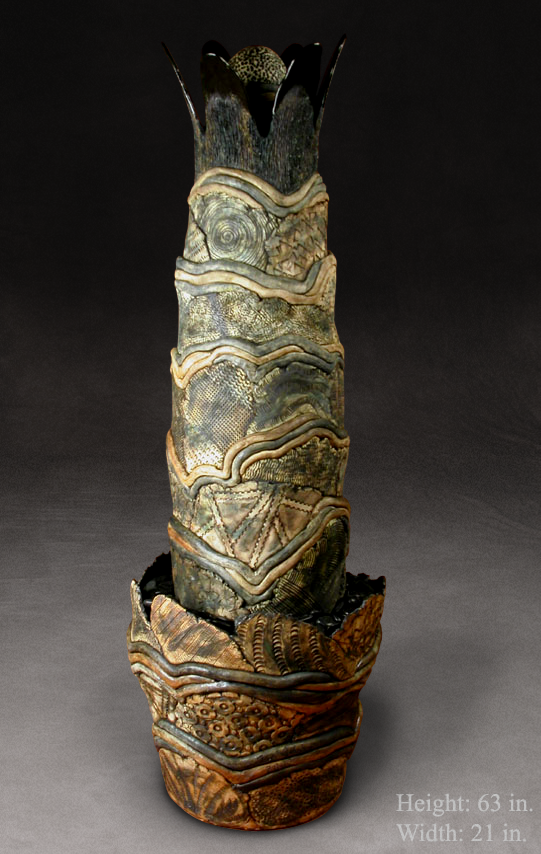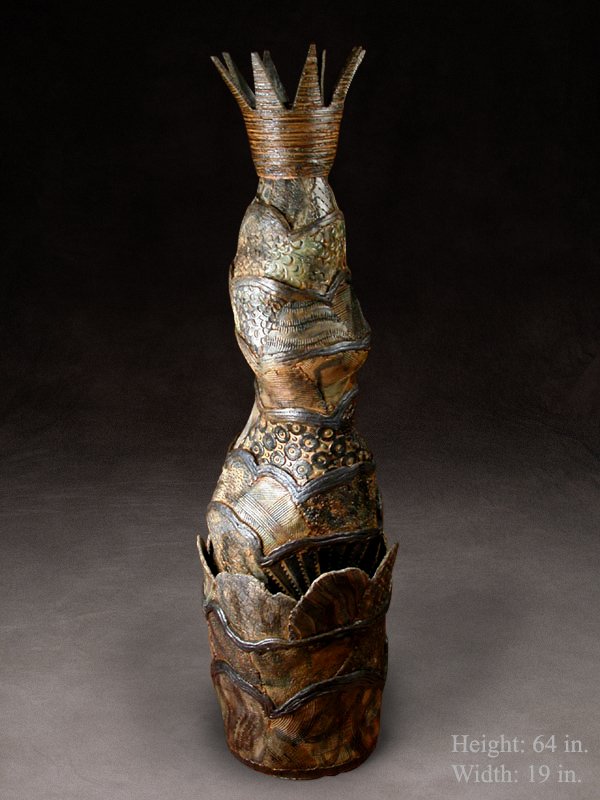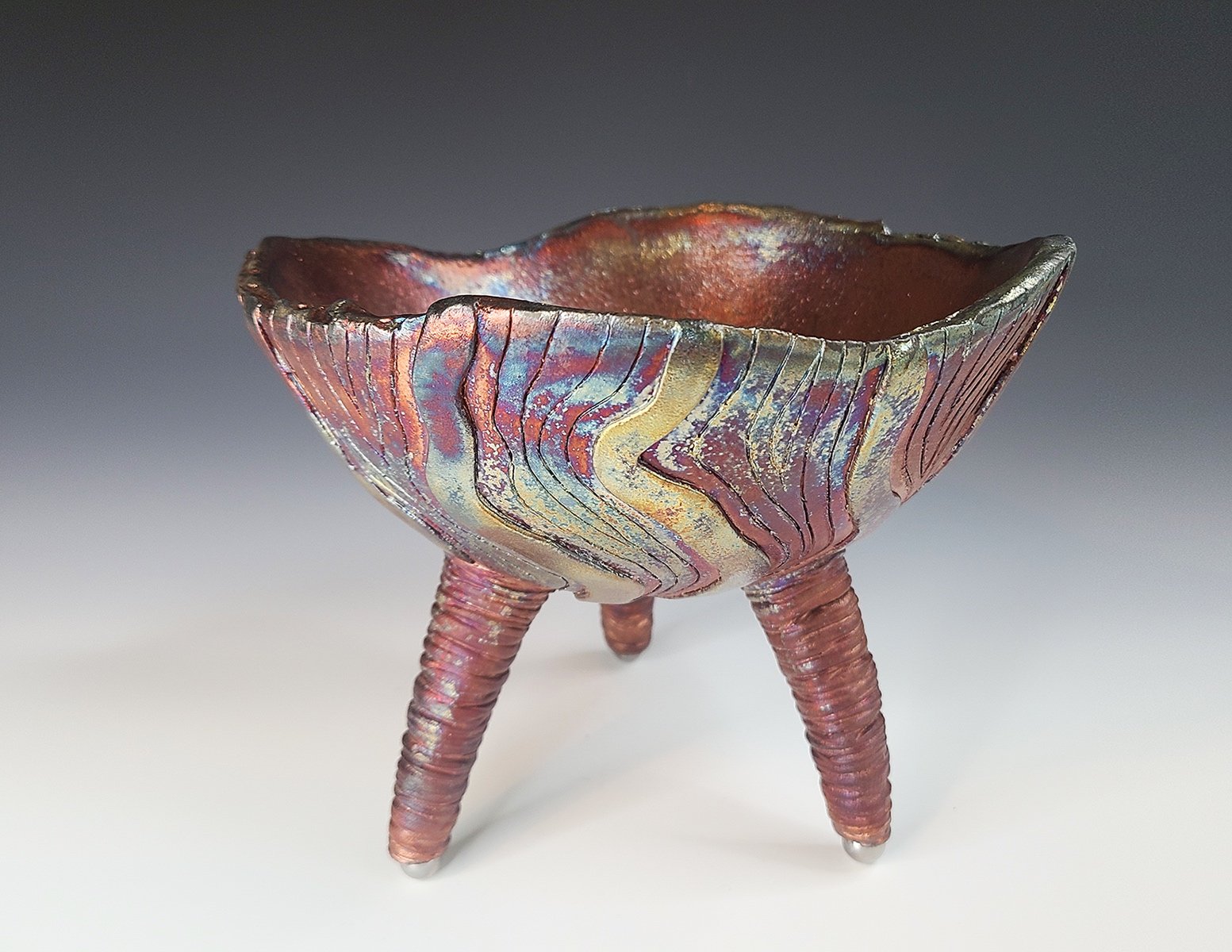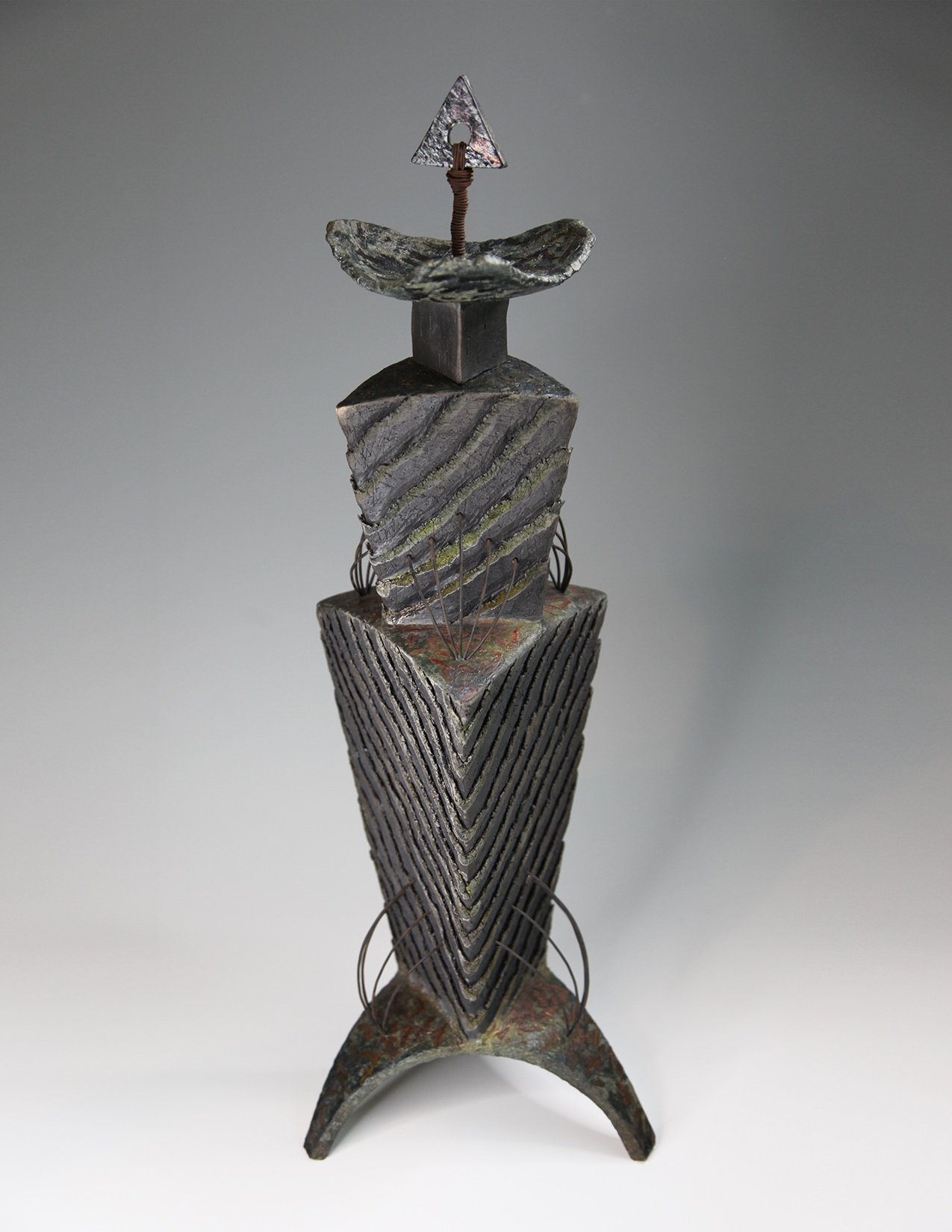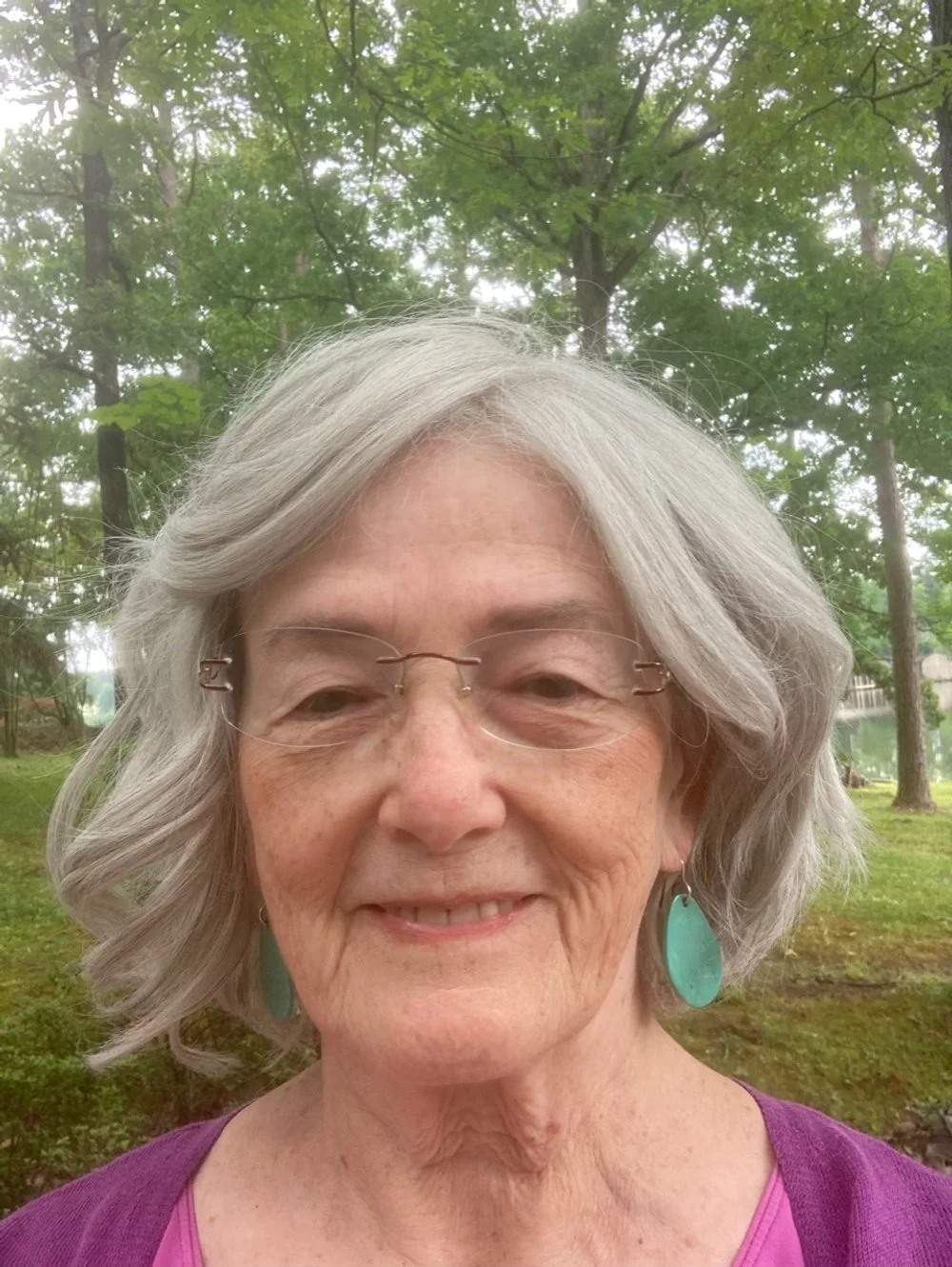Interview with artist Trip Johnson
Trip Johnson is a ceramic sculptor living and working in Fayetteville. His imaginative functional sculptures are complex and tactile and demand that they be explored. More of Trip’s work can be found at Curated in Eureka Springs, The Art Collective in Rogers, the Community Creative Center, Fayetteville, and at his Instagram.
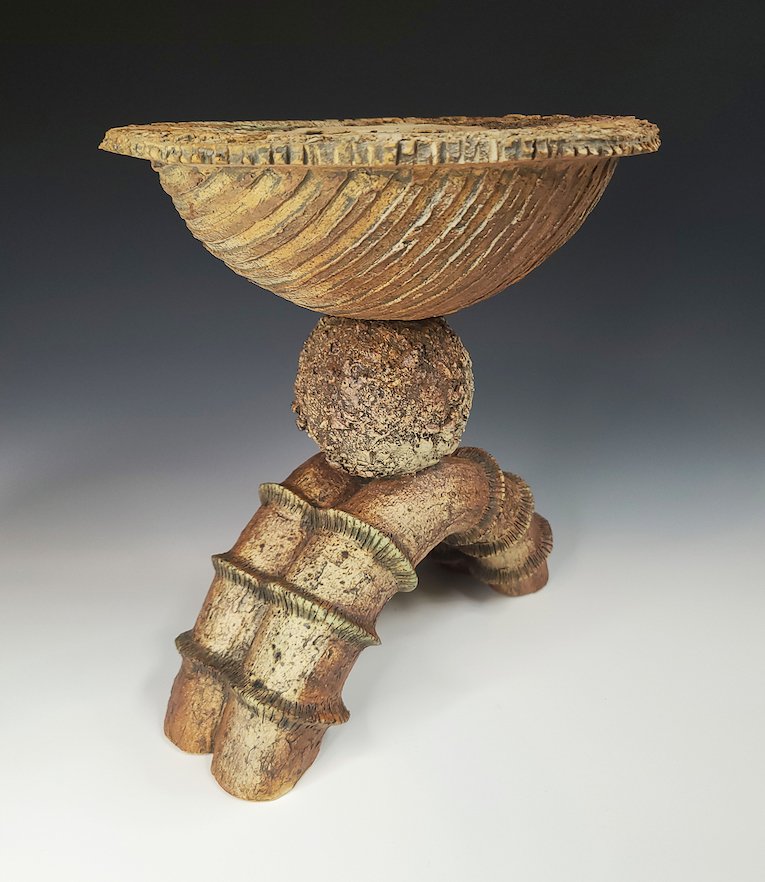

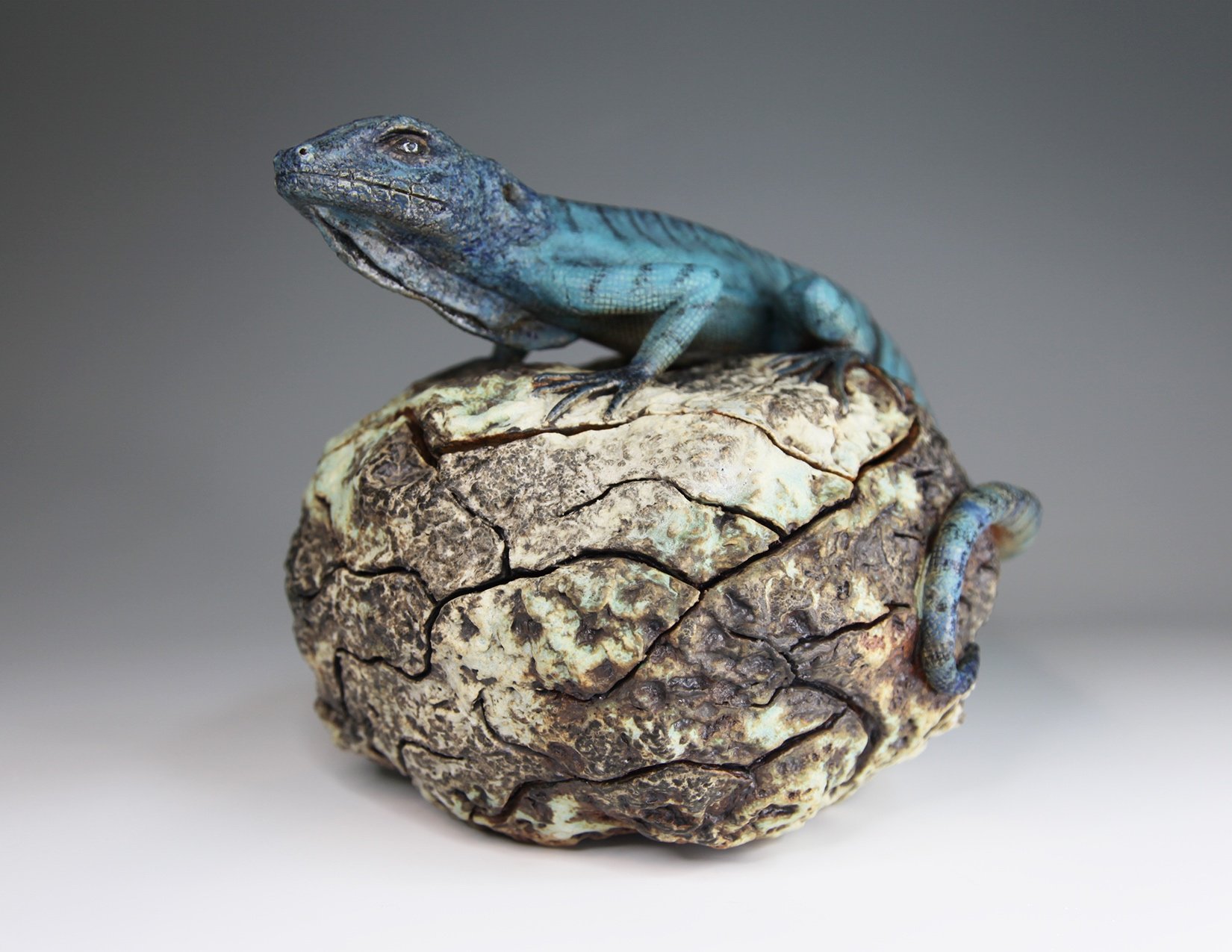
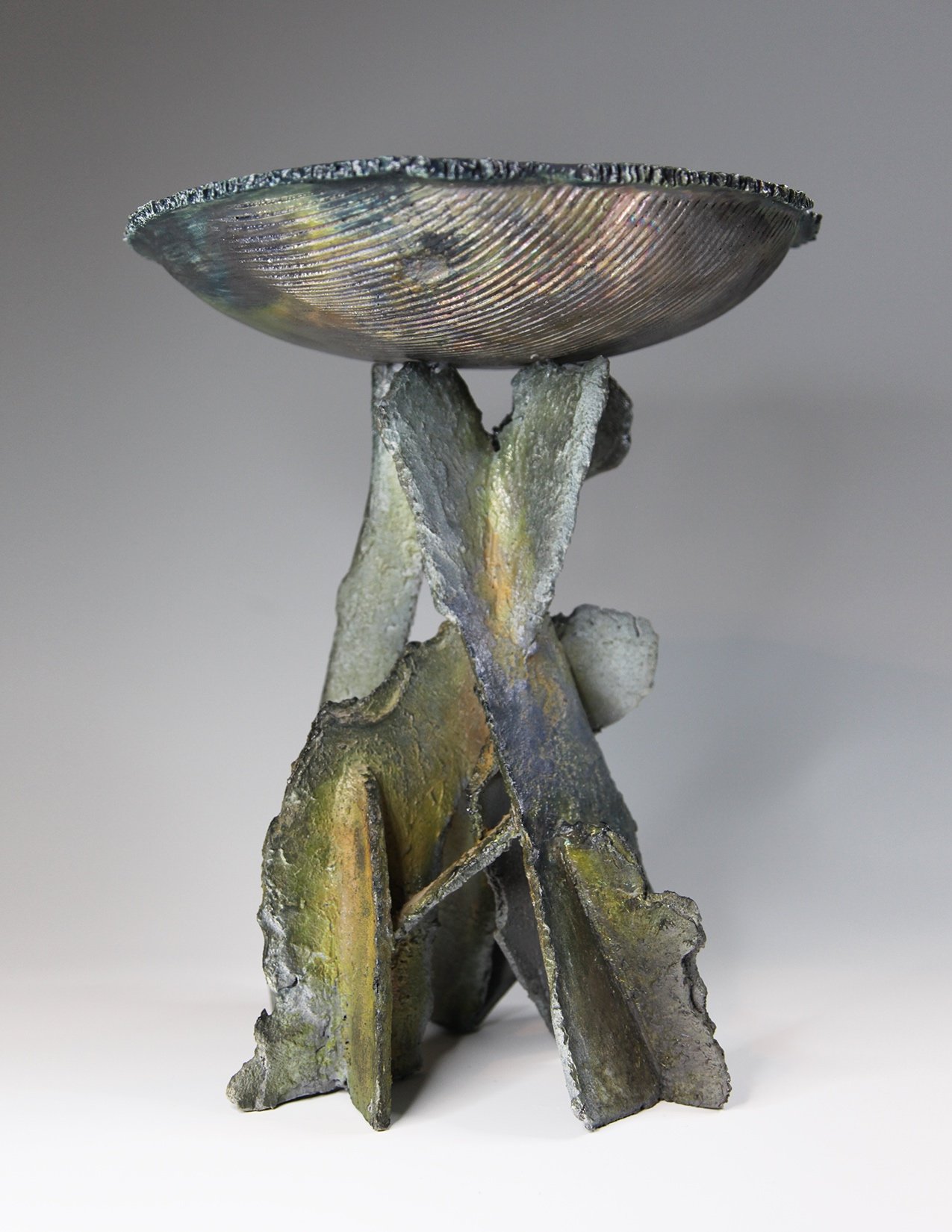
AAS: Trip, tell me about yourself. Are you originally from Arkansas?
TJ: I’m originally from Missouri. I grew up in a small town called Dresden; I was 5 when we moved there from North Dakota. My dad was in the Air Force, and he recently retired so Whiteman Air Force base was located about 15 miles away and that base was part of his decision process for choosing Missouri to move his family to. I moved to Sedalia when I was a freshman and I attended Smith Cotton H.S. I graduated in 94’ and started attending State Fair Community College that following semester. After earning my associate degree, I took a year off to work, then I moved down to Springfield to attend Missouri State University. It was Southwest Missouri State at the time. After changing my major a few times, I finally received a BFA in Computer Animation in 2002. After graduating I immediately enrolled in more ceramic classes that following semester because I wanted to take advantage of their facilities in order to make large scale water fountains. The ceramics department had large walk-in kilns that would accommodate the 5ft tall fountains. I did some freelance work with my roommate around the same time, as well as maintaining my job working for Walmart while I attended school. The freelance thing didn’t work out, my roommate got a job in Kansas City and moved so I left Springfield and moved back home for a summer while I looked for a job. I eventually landed a job with BRR Architecture as a 3D graphic designer. I accepted the job knowing that I would train in the Merriam, Kansas home office for a few months and then I would be relocated to Lowell, Arkansas, where they were opening a satellite office. This was around the time Walmart required all their vendors, consultants, and business partners to have some type of presence in NWA. At the time, Walmart was BRR’s largest client, so I was part of the 5-man team that opened that satellite office. I moved to Arkansas in December 2003 and it’s been home ever since.
AAS: When did you first start drawing or painting? I assume your love of ceramics came later?
TJ: I found that I had a talent for drawing at an early age. I drew birds and dinosaurs when I was five. I started out mimicking pictures or photos from books and magazines. I was always able to reproduce objects on paper with proper proportion and scale and I seemed to understand shadow and light. I was good with color and my brain just clicked for drawing and painting very early in life. I was known in my elementary school as the kid who was an artist and the go to for anything that required creativity. My parents were always supportive of my interest in art creation and always encouraged me to do more.
My first experience with clay didn’t come until I was a freshman in high school. I took Ceramics I with Ms. Elizabeth Ritter and she would later become a mentor and an inspiration for some of my work even today. Most of the students didn’t take art seriously and they looked at a class like ceramics as an easy A. Then you had a few who were really good at it, enjoyed it, and took it seriously. I was one of those kids and I really fell in love with the tactile manipulatable quality clay provided, as well as the firing and glazing process. I ended up creating pieces in that class that I would later submit to the Missouri 50 juried art competition they have every year at the Missouri State Fair. I ended up winning first or best in show every year I entered. I would end up taking another Ceramics class with Ms. Ritter before graduating, in fact, I ended up taking every art class my high school offered.
AAS: Ceramics take a lot of time – long blocks of time. What keeps bringing you back to work in ceramics?
TJ: The ceramics process can be time consuming, but I find the whole process therapeutic. I’ve had a few major life changes in the past three years that have given me pause and the need for reflection on life and what my path moving forward will look like. I divorced from a 13-year marriage in 2019 and was laid off from my corporate job at the end of 2020. Those two events were pretty major for me and made me step back and re-evaluate. I still haven’t completely figured it out yet but being back in the studio creating art has been a type of therapy for me. When I’m there working, all my stresses and worries melt away and I’m just in the moment of creating and being creative. I’ve always been good with my hands, figuring things out and problem solving. I’ve worked with all kinds of different materials to make art, but I’m always drawn to clay due to the instant malleability, endless finishing possibilities, and ability to make organic forms, which is considerably harder to do in materials like wood or metal.
AAS: You describe yourself as a ceramic sculptor and one of my favorite sculptural pieces is Triangle Urn in White. Tell me about that form and the elements you’ve incorporated into the sculpture.
Triangel Urn in White, 7”w x 21”t, stoneware
TJ: I consider myself a ceramic sculptor rather than a potter. A potter focuses on functional ceramic work, and they use the wheel for creation. I’m more of a hand builder and some of my work is functional but I lean more towards the sculptural side of ceramics. I do throw on the wheel, but I usually end up manipulating my thrown pieces and turning them into a sculptural piece of some type.
My triangle urns are some of my favorite forms to make and look at. I call it an urn because it’s hollow and has a lid but realistically that’s where its functionality ends, it’s really a sculpture rather than a functional piece. I made the first one in 2003 when I moved back home for the summer. I ended up working with Elizabeth Ritter in her studio space those few months before I started working for BRR. I don’t remember how I came up with the idea for the form, I just remember that the piece worked visually. I incorporated metal wire into the design in order to fill dead space and create visual balance around the piece. I’ve always liked to incorporate other materials into my pieces whether it be wire, wood, ball bearings, or magnets. These triangle urns are created using 12 different clay pieces which require a lot of scoring and slipping to ensure it’s held together properly. This particular piece was fired in an electric kiln to cone 6 and I used Coyote commercial glazes as well as some stains that I created. I layered stains, glazes, and stains on top to create an aged rustic look to the finish. I like the contrast of the black and white as well.
AAS: I want to ask you next about Arched Footed Bowl in Green. It is an extraordinary piece. Did you use your expertise in 3D rendering to help in its design and construction?
Arched Footed Bowl (Green), 9”w x 10.5”t, stoneware
TJ: There is a funny story behind the design of this form. Typically, I sketch out my designs before I create them in a sketchbook I keep with me for when an idea pops into my head. This particular piece is unique because the idea came from my 10-year-old son. One day in 2021 he had an AMI day from school due to bad weather. We finished his schoolwork and I decided to get out some plasteline and have a little arts and crafts session on the dining table. He and I played around with making different shapes and forms out of plasteline. He made about five different forms, and I asked him which one was his favorite. He picked one and I told him that he should recreate it out of clay, and I would fire it for him, and he could glaze it. We both liked the way it turned out and he asked me to recreate the piece. I believe his exact words were, “ok, now you re-make it for real.” I ended up adding my own flare and design elements to it, but the basic form is the exact same one he created, arched foot, ball, bowl on top. These make up the three basic parts of the piece. I threw a donut on the wheel so it’s a hollow tube. I cut it in half and attached the two halves together. The ball is about 1.5 lbs of clay cut in half, hollowed out then put back together. The bowl on top is just a slab over a plaster hump mold I created. I use a circle protractor to create the overlapping circle grid design pattern which I like a lot and the visual element it creates. The bowl is a separate piece attached to the base using earth magnets. I really enjoy making the form and I like experimenting with different finishing techniques. I’ve made about six of them so far and plan to make more in the future.
AAS: Then there is Bubble Bowl in Gold. I can’t help but smile when I look at it.
Bubble Bowl in Gold, 11”d x 7”t, stoneware
TJ: The bubble bowls are also another favorite of mine. I’ve made four of them so far and the only reason I haven’t made more of them is because they are time consuming and tedious to make. Each cup is an individual slab over an aluminum cup mold that I use as a hump or slump mold depending on the size I need. I then use a plaster hump mold that makes up the basic bowl shape and use it to attach each individual cup together by the score and slip method. Each leg has the table contact point carved out to accommodate a ball bearing. I then carve in small holes in each bubble shape to accommodate a small ball bearing. The ball bearings add an extra visual element as well as contrast to the piece. The glaze used on this piece is called Saturation Gold. This particular glaze requires many, many coats in order to achieve the gold look.
AAS: I would think that experimenting with glazes and stains and firing techniques is a fun challenge for you?
TJ: Finishing techniques is the ultimate challenge because the possibilities are endless. I’m a firm believer in that this artistic discipline is all about the finish and not the form. I feel like you can take an amazing form and ruin it with a crappy not well thought out finish. Yet you can take a mediocre form and make it great with an amazing finish technique. I try and marry a fine balance between both form and finish, but I put a lot of thought and experimentation in trying to perfect my finishing techniques. I feel like I’ve barely even scratched the surface of what is possible and I’m constantly experimenting and learning. The first thing I did when I got back in the studio was create loads of test tiles and start experimenting with stain and glaze recipes. I’m a stickler when it comes to test tiles and if you saw my notebook, you’ll see that I have over 100+ test tiles and each one of those tests have multiple experiments of stains and glazes overlapping each other with different thicknesses and different clay bodies. The last thing I want to do is spend 10+ hours on a piece and then ruin it with the finish. My finish technique is all about layering. I typically start with a stain, then I add glaze or glazes, then layer stains over the glazes. I like to create an aged worn look rather than a super glossy pristine exterior. Some of my work is shiny and polished but I tend to tone that down using texture. Most of my work is extremely texture heavy which I use for visual appeal as well as hiding imperfections in symmetry or form.
The other thing to keep in mind is that this discipline is so subjective. What I might think looks amazing, someone else might think it looks like crap. That’s why artists find it funny when some of their work sells and other pieces don’t. I’ve had pieces sell that I wasn’t completely pleased with the finish, yet the piece I absolutely love will sit for months. This goes back to the subjective nature of ceramics or art in general.
AAS: Black Texture Vase is a piece that required several techniques, I am guessing, to achieve its amazing look of stone and glass? Tell me about it.
Black Textured Vase, 6”w x 8”t, stoneware
TJ: This piece is a prime example of why I use texture in my pieces. This was created using a poorly made plaster hump mold. The mold was lying around the studio and was made by someone else, but I liked the shape and decided to use it for a piece. The main body of the piece is made up of two separate pieces using this hump mold. When I attached them together, I quickly realized that the mold wasn’t symmetrical. I scored and slipped the entire piece and added clay scrap chunks that I keep in a bowl for slip making. I rubbed those clay scraps over the whole piece, which provided the stone like texture and help hide the symmetry imperfection. After bisque firing the piece, I decided to stain the whole piece and use some commercial glazes that were dark in color to also help with hiding the imperfections. I believe the end result turned out nice and is a testament to how to use texture and glaze techniques to hide symmetry or imperfection issues. The average viewer would never know why I did what I did, they would just think it was all planned from the beginning. Any artist will tell you that you need to be flexible with your plan, execution, and expectations as issues or opportunities present themselves during the creative process.
AAS: Are you influenced much by mythology and sci-fi? Crackle Orb has a Nordic Game of Thrones look to me. It is a marvelous piece. Where do you think these shapes come from in your mind?
Crackle Orb, 7.5"w x 15"t, stoneware
TJ: I’m not as influenced by mythology or sci-fi as I am with other artists well known and not so well known. I’m also influenced by nature and natural things like stone, bark, basically anything with texture that I find visually appealing. One artist who inspires me is Tom Coleman. I would classify Tom as a ceramic sculpture although most of his work is done on the wheel.
Crackle Orb is another piece that was inspired by my son’s creation while playing with plasteline. Another one of his forms that he and I both liked was a form similar to crackle orb. I took some creative liberties with some of the design elements, but the shape was basically his. It’s a form that I enjoy making, but my plan in recreating these forms is to inspire him to continue to design and exercise his creativity. I didn’t have a plan for the finish when I created it. I really like this black crackle glaze and I felt like it would help hide the lid line. I also wanted to accent the texture on the base and lid element with stains and a glaze that contrasted the matt black finish of the crackle glaze.
AAS: Trip, what can we expect next from you?
TJ: I’m going to continue to try and branch out and get my work in front of more people. I’m currently selling my work in Eureka Springs at Curated, in Rogers at The Art Collective, and Fayetteville at the Community Creative Center. I’m going to look into galleries in Tulsa and Kansas City, both have a pretty robust art scene. I’m still going through the price discovery phase. I have an Instagram account that is currently acting as an online portfolio of my latest work but I plan to set up a website once I have more of a following. I’m also going to look into any art competitions that make sense to try and enter. I’m just going to be working on new designs, new finishing techniques, and trying to perfect upon what I already know.
I’ve enjoyed working with the folks at the Community Creative Center and although most of them are potters, I still find inspiration in seeing what other artists are working on. I’ve also received lots of helpful advice from Bryce Brisco (Executive Director of the CCC) I would like to thank my son for being an inspiration and my parents for being supportive. I’m going to continue to create art and hopefully find an audience that appreciates my style and aesthetic in design, color, and form.
